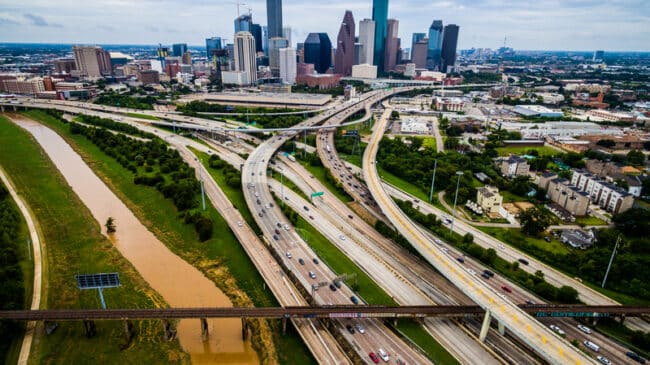In recent years, Texas legislators have reversed the state’s embrace of tolling and long-term public-private partnerships that led to multi-billion-dollar express toll lane projects in the Dallas-Fort Worth and Houston metro areas. Long lists of proposed public-private partnerships to expand formerly planned networks of express toll lanes in those two metro areas have been rejected by state legislators. Most recently, the state has de-privatized the State Highway 288 express toll lanes public-private partnership project thanks partly to a poorly written termination-for-convenience clause in the long-term agreement.
Yet, despite the actions of the Texas Transportation Commission, the state legislature, and the Texas Department of Transportation (TxDOT), two contradictions are visible in tolling in the state.
First, the legacy toll agencies and the newer regional mobility authorities continue to add tolled capacity in their metro areas. Also, TxDOT plans to keep variable tolling in place on the SH 288 express lanes, albeit at lower rates than the P3 company has been charging. It also continues operating its revenue-financed express toll lanes on I-35 East in Dallas, rated BBB+ by Fitch.
Why the local toll-mobility agencies have not been targeted as part of the state leaders’ anti-tolling efforts is unclear to this non-Texan. Perhaps it’s respect for local control for which no opposing legislative majority could be assembled. Or perhaps those local agencies have powerful supporters with political clout in the state capitol. Regardless of why, I’m glad to see additional user-financed highway projects continuing to be built in fast-growing Texas.
The contradiction over express toll lanes is even more difficult to understand. Variably priced express toll lanes are proliferating in other fast-growing states. The reason is that they work so well. Variable pricing is the only proven way to enable traffic to flow uncongested, even at peak times of day. That’s why multi-billion-dollar express toll lane projects are under way in Atlanta, Charlotte (second one close to getting the green light), Nashville, Tampa, and with more on the way in the suburbs of northern Virginia outside Washington, DC.
Often lost in debates over express toll lanes is their very significant transit benefits. With a light rail transit project, the transit agency must acquire the right of way and build an exclusive guideway before adding trainsets and electrification. But an express toll lane offers a “virtually exclusive” guideway for express bus service. And that bus service is more flexible than light rail because the same vehicle can collect passengers from one or more park-and-ride lots and deliver passengers to several job locations—a “one-seat ride.” All the transit agency needs to pay for are the vehicles and possibly additional park-and-ride lots. Such a deal—better transit service at a fraction of the cost.
TxDOT is today stuck with plain old high-occupancy vehicle (HOV) lanes, which it now plans to implement as “managed” HOV lanes, such as in the long-overdue reconstruction of I-35 through Austin. But HOV lanes are not managed by being limited to carpools and buses. Given Texas’s very high growth rate, any new HOV lanes in high-traffic corridors will fill up rapidly with fam-pools, violators, and buses—and the lanes will be congested during peak periods. In these cases, no other Texans will have faster and more reliable time-sensitive trips that people willingly pay for in Dallas, Houston, and Fort Worth on the highly used express toll lanes in those metro areas. Also say goodbye to the original plans for a whole network of express toll lanes in the DFW metro area.
The contradiction I have the most trouble understanding is TxDOT’s decision to keep the SH 288 express toll lanes in operation but with much lower toll rates. This will not satisfy those SH 288 drivers who want to use those lanes without paying anything. But it will also reduce the reliable time savings provided thus far by market-based variable toll rates. The method in the madness may be that under TxDOT-set toll rates, the SH 288 express lanes will fail, providing an excuse to eliminate the tolls.
By the way, the only other case I know of where a revenue-financed P3 express toll lanes project was terminated for convenience was the very first one: State Road 91 in Orange County, CA. When CalTrans decided to terminate that long-term agreement, the compensation was based on fair market value, as estimated by an expert firm agreed to by both parties. A strong grass-roots movement believed the termination would lead to the elimination of the variable tolls. Wrong! They remain in operation more than two decades later for two reasons.
First, the revenue was needed to service the new debt Orange County Transportation Authority issued to pay for acquiring the project.
Second, the congestion-reduction and travel-time reliability benefits were far too valuable to give up. They are also the only express toll lanes rated A+ by Fitch Ratings.
Due to being forbidden from using revenue-financed public-private partnerships, TxDOT is also doing a disservice to the state’s smaller cities and rural counties, which all need highway and bridge improvements. As I explained at the 2023 Tarrant Transportation Summit, TxDOT plans to spend $8.1 billion on three major projects with “HOV managed lanes” in Austin, Dallas, and San Antonio—where revenue-financed P3s would be far more effective. If those three major projects were procured with revenue-financed express toll lanes, with 80% of the project cost financed based on toll revenues, that would free up $6.5 billion for the state to use on projects in smaller cities and rural counties.
In Texas, the state legislature meets every other year, and 2025 is one of those years. State leaders should reconsider their current anti-toll, anti-public-private partnership policies.
A version of this column first appeared in Public Works Financing.

